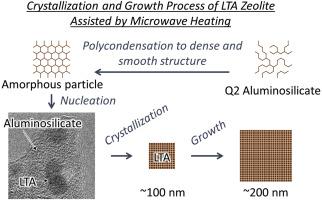微波加热辅助烷氧基化物 LTA 沸石的结晶过程
IF 4.7
3区 材料科学
Q1 CHEMISTRY, APPLIED
引用次数: 0
摘要
微波加热(MH)反应快速、均匀,是一种很有前景的沸石合成方法。然而,微波合成反应的详细过程及其促进机理仍在研究之中。本研究以水解的 Al 和 Si 烷氧基为原料,通过 300 W 的 MH 水热合成了 LTA(Linde Type-A)沸石。通过核磁共振波谱(29Si NMR)、小角 X 射线散射(SAXS)、X 射线衍射(XRD)、透射电子显微镜(TEM)、动态光散射(DLS)和扫描电子显微镜(SEM)阐明了 LTA 的形成过程。29Si NMR 和 SAXS 分析表明,前驱体溶液中的铝硅酸盐线性聚凝物在 MH 作用下立即转变为致密堆积结构。TEM 观察结果表明,在 MH 之前,无定形的纳米硅酸铝颗粒中已经形成了几纳米的结晶相,而 XRD 则表明,在 MH 400 分钟之前,无定形相已经转变为 LTA 相。这与之前通过常规加热和 MH 两种方法辅助合成沸石的研究结果基本一致。通过 DLS 和 SEM 图像测量了铝硅酸盐/LTA 的粒度,并根据反应产物的重量计算了产率。换句话说,溶液中的所有硅酸铝在 12 小时前已经聚结成不溶解的颗粒,然后在 36 小时前通过溶解-再沉淀或团聚的方式使颗粒长大。本文章由计算机程序翻译,如有差异,请以英文原文为准。

Crystallization process of LTA zeolite from alkoxides assisted by microwave heating
Microwave heating (MH) is a promising way for zeolite synthesis in terms of rapid and uniform reaction. However, detail process of the synthesis reaction and mechanism of its promotion by microwave are still under investigation. In the present study, LTA (Linde Type-A) zeolite was hydrothermally synthesized by 300 W of MH from hydrolyzed Al and Si alkoxides. The formation process of LTA was elucidated by nuclear magnetic resonance spectroscopy (29Si NMR), small angle X-ray scattering (SAXS), X-ray diffraction (XRD), transmission electron microscopy (TEM), dynamic light scattering (DLS) and scanning electron microscopy (SEM). 29Si NMR and SAXS analyses suggest that linear polycondensates of aluminosilicate in the precursor solution was immediately transformed into densely packed structure by MH. TEM observations reveals that crystalline phase with several nanometers was already formed in amorphous aluminosilicate nanoparticles prior to the MH while XRD shows that the amorphous phase had been transformed to LTA phase until 400 min of MH. It is basically consistent with the previous studies among zeolite synthesis assisted by both of conventional heating and MH. The aluminosilicate/LTA particle size was measured by DLS and SEM image as well as the yield was calculated from weight of the reaction products. The particle gradually grew up to 242 nm in diameter until 36 h while the yield sharply increased to nearly 100 % during 6.7 h and 12 h. In other words, all aluminosilicate in the solution once had polycondensed to form insoluble particle until 12 h followed by particle growth by dissolution-reprecipitation or agglomeration until 36 h.
求助全文
通过发布文献求助,成功后即可免费获取论文全文。
去求助
来源期刊

Microporous and Mesoporous Materials
化学-材料科学:综合
CiteScore
10.70
自引率
5.80%
发文量
649
审稿时长
26 days
期刊介绍:
Microporous and Mesoporous Materials covers novel and significant aspects of porous solids classified as either microporous (pore size up to 2 nm) or mesoporous (pore size 2 to 50 nm). The porosity should have a specific impact on the material properties or application. Typical examples are zeolites and zeolite-like materials, pillared materials, clathrasils and clathrates, carbon molecular sieves, ordered mesoporous materials, organic/inorganic porous hybrid materials, or porous metal oxides. Both natural and synthetic porous materials are within the scope of the journal.
Topics which are particularly of interest include:
All aspects of natural microporous and mesoporous solids
The synthesis of crystalline or amorphous porous materials
The physico-chemical characterization of microporous and mesoporous solids, especially spectroscopic and microscopic
The modification of microporous and mesoporous solids, for example by ion exchange or solid-state reactions
All topics related to diffusion of mobile species in the pores of microporous and mesoporous materials
Adsorption (and other separation techniques) using microporous or mesoporous adsorbents
Catalysis by microporous and mesoporous materials
Host/guest interactions
Theoretical chemistry and modelling of host/guest interactions
All topics related to the application of microporous and mesoporous materials in industrial catalysis, separation technology, environmental protection, electrochemistry, membranes, sensors, optical devices, etc.
 求助内容:
求助内容: 应助结果提醒方式:
应助结果提醒方式:


